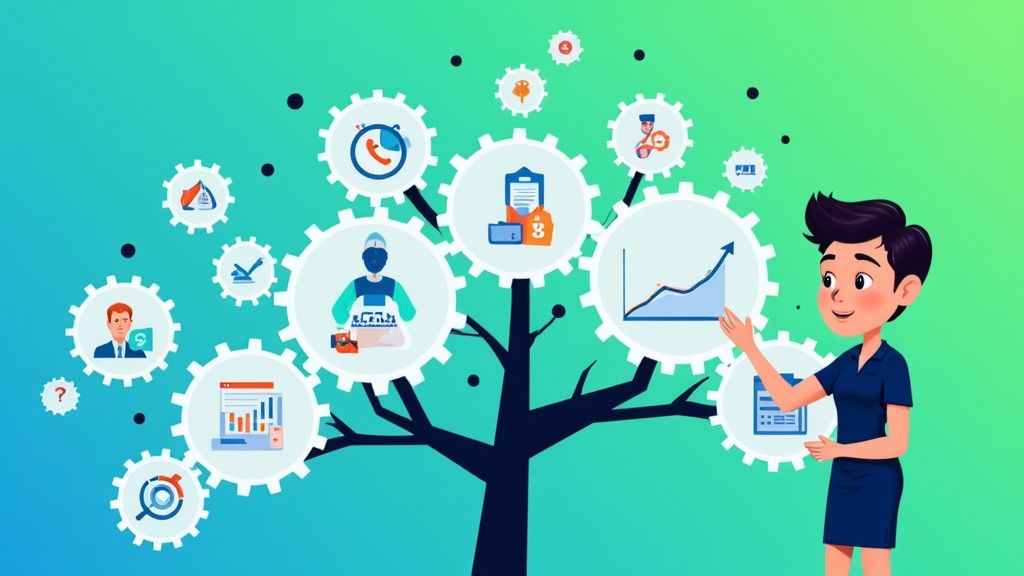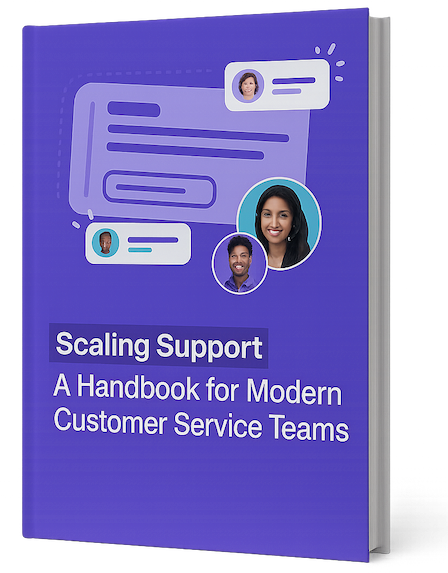Understanding the True Cost of Customer Churn
When it comes to business growth, many companies focus heavily on acquiring new customers while underestimating the impact of losing existing ones. The math seems simple on the surface – lost customers equals lost revenue. However, the real financial impact runs much deeper. Studies show that even a modest 5% reduction in customer churn can increase profits by up to 125%. This stark reality highlights why keeping current customers happy is just as crucial as bringing in new ones.
The Hidden Costs Beyond the Numbers
Losing a customer impacts far more than just monthly recurring revenue. Think about all the resources that went into winning that customer in the first place – the marketing budget spent on campaigns, the sales team's time and effort, and the costs of getting them up and running with your product. When customers leave, those investments walk out the door with them. But that's not all. Unhappy former customers often share their negative experiences with others, damaging your brand's reputation and making it harder to attract new business. This creates a snowball effect that can seriously hurt your company's growth potential.
Service Issues: A Major Culprit
While many assume product problems drive most customer departures, the data tells a different story. Research shows that nearly 70% of customers leave because of poor service experiences, not product issues. This reveals just how much customers value quality support. When people encounter unhelpful representatives or get stuck with unresolved problems, they're far more likely to switch to a competitor. The key takeaway? Making customer service a top priority is essential for keeping churn rates low.
Calculating Your True Churn Cost: A Practical Framework
To get the full picture of how customer churn affects your business, you need to account for multiple factors:
| Factor | Description |
|---|---|
| Lost Revenue | The recurring revenue lost due to the churned customer. |
| Customer Acquisition Cost (CAC) | The total cost associated with acquiring the lost customer (marketing, sales, etc.). |
| Onboarding Costs | Expenses related to onboarding the churned customer, including training and support. |
| Lost Referrals | The potential revenue lost from referrals that the churned customer might have generated. |
| Reputational Damage | The intangible cost associated with negative reviews and brand perception, which can impact future acquisitions. |
By examining each of these elements, you can better understand the true financial impact when customers leave. This detailed view helps you make smarter decisions about where to focus your retention efforts and how much to invest in keeping customers satisfied. Rather than treating churn as just another metric, use this framework to build a stronger case for customer retention initiatives.
Data Analytics: Predicting Customer Behavior

Understanding why customers leave is essential for reducing churn rates. While basic metrics provide surface-level insights, truly grasping customer decisions requires a deeper analysis combining behavioral patterns, sentiment data, and predictive models. Consider a subscription service that notices declining usage from a previously active customer. When combined with negative feedback in support conversations, these signals can point to a high risk of that customer leaving – allowing the company to step in before it's too late.
How Behavioral Data Reveals At-Risk Customers
Customer interactions with your product tell an important story about their engagement level and satisfaction. Key metrics like how often they log in, which features they use most, and their history of support requests provide early warning signs of potential issues. For example, if someone who typically logs in daily suddenly drops to weekly usage, or if they start submitting more support tickets than usual, these behavior changes often signal growing dissatisfaction. Regular customer surveys and review monitoring add valuable context to these quantitative metrics, helping build a complete picture of the customer experience.
Using Sentiment Analysis to Read Customer Emotions
Going beyond raw data, sentiment analysis helps companies understand the emotions behind customer interactions. By examining the tone and content of support conversations, survey responses, and social posts, businesses can pick up on subtle signs of frustration or delight that numbers alone might miss. For instance, a customer might calmly report a technical problem, but sentiment analysis could reveal underlying annoyance in their word choice and phrasing. This emotional insight helps companies address issues before they lead to churn.
Machine Learning and AI: The Future of Churn Prevention
By combining historical customer data with current behavior patterns and sentiment analysis, machine learning models can now predict which customers are most likely to leave. These systems identify subtle patterns in how past churned customers behaved before leaving, then flag similar patterns in current customers. This allows companies to take targeted action – perhaps offering personalized promotions, reaching out with proactive support, or highlighting relevant new features based on that customer's needs. The models get smarter over time as they process more data, leading to increasingly accurate predictions and more effective retention strategies. Through this data-driven approach, businesses can spot potential issues early and take meaningful steps to keep valuable customers engaged.
Building a Customer Service Strategy That Actually Works
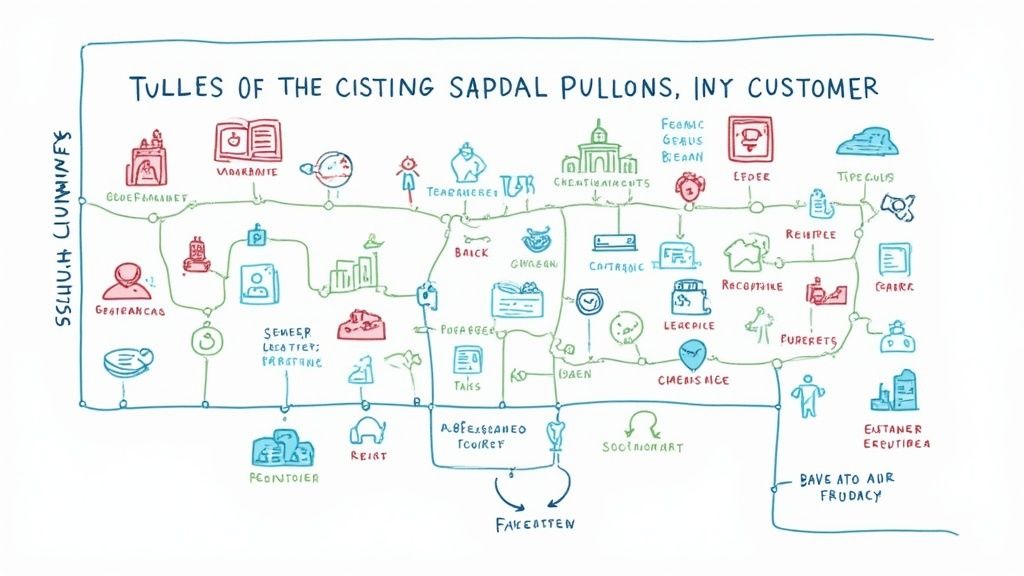
After examining how data analytics helps predict customer behavior, let's focus on creating an effective customer service strategy to reduce churn. The stakes are high – research shows that 91% of unhappy customers simply leave without saying anything. This means exceptional service isn't optional – it's crucial for keeping customers. Let's explore practical ways to turn your service team into a powerful force for customer retention.
Training Your Team for Proactive Engagement
The best customer service anticipates needs before problems grow. This takes more than just answering questions – your team needs the skills to spot and fix issues at their source. For example, when a customer calls about a basic technical question, a skilled rep might pick up on frustration in their voice and dig deeper. This could reveal bigger usability problems that, left unchecked, might cause that customer to leave.
To build these proactive service skills, focus training on:
- Empathy and Active Listening: Teaching reps to read emotional cues and truly understand customer concerns
- Problem-Solving and Critical Thinking: Looking past surface issues to find and fix root causes
- Product Knowledge: Giving reps deep product expertise so they can spot potential issues early
- Effective Communication: Ensuring clear, helpful interactions across email, chat, phone and other channels
Implementing Effective Communication Strategies
Good customer service depends on clear, helpful communication at every touchpoint. This means going beyond just answering questions – each interaction should make customers feel heard and valued. Creating specific guidelines for different channels helps maintain quality and consistency.
Here's what this looks like in practice:
- Email: Personal responses that directly address the customer's specific situation and offer clear next steps
- Chat: Quick, friendly help that solves problems in real-time
- Phone: Patient listening, clear explanations, and going above and beyond to help
Turning Service Into a Retention Tool
When you put these strategies into action, customer service becomes more than troubleshooting – it actively builds loyalty and keeps customers around. This matters because about 70% of customers leave due to poor service experiences, not product issues. By investing in proactive, empathetic service, you directly address one of the biggest causes of customer churn. Better service leads to happier customers who stick around longer, helping your business grow steadily over time.
Creating Recovery Programs That Save At-Risk Customers
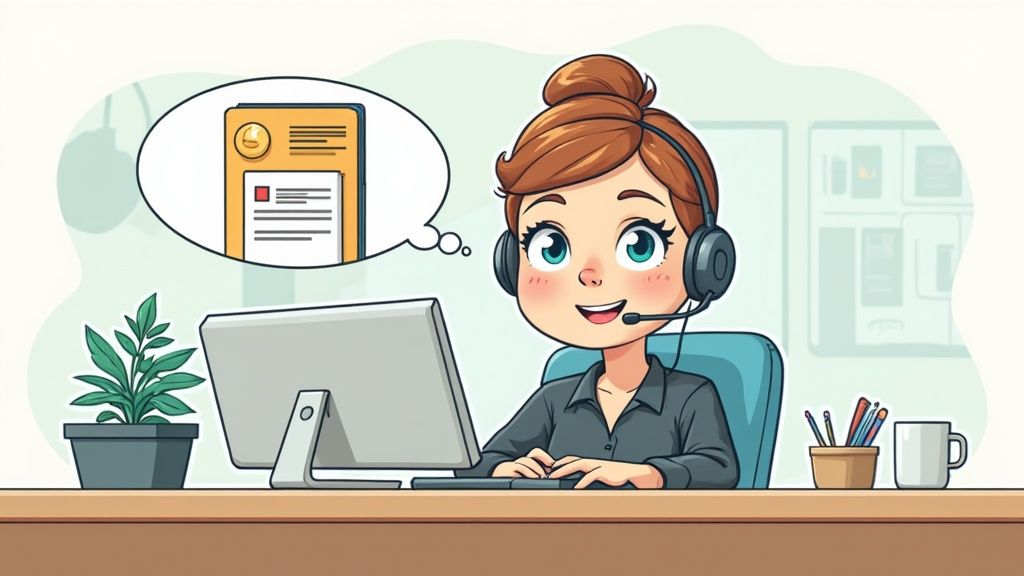
Once you've built strong customer service practices, the next step is creating programs to actively keep customers from leaving. This goes beyond just sending win-back emails – it requires a complete strategy to identify and help customers who might cancel soon. The most effective approaches blend automation with personal connections. When done right, these programs can save up to 72% of customers who were planning to leave.
Automating the Essentials: Card Updaters and Retry Logic
Many customers leave unintentionally due to payment issues, but good automation can prevent this. Card updaters automatically fix expired or invalid payment details before they cause problems. For example, if a customer's credit card expires mid-month, the system can update their card info automatically – keeping their service running smoothly instead of getting cut off due to failed payment. Smart retry systems also help by trying failed payments again at strategic times using different methods. This keeps transactions moving without bombarding customers with notices. Together, these automated tools create an important safety net that keeps revenue steady and customers happy.
Dunning Campaigns: Balancing Persistence With Empathy
Following up on failed payments (dunning) requires careful balance. While you need to be persistent about collecting payment, pushing too hard can drive customers away permanently. Good dunning programs use automated email sequences that gradually increase urgency while staying helpful. The first message might just remind them about the failed payment with easy ways to update their info. Later messages can explain what happens if they don't pay, always including clear steps to fix things. This step-by-step approach respects customers while making sure they know what's at stake.
The Human Touch: Personalized Outreach for High-Value Customers
While automation helps handle routine issues, personal outreach remains essential – especially for your most valuable customers. Having a dedicated support person call to understand why they missed a payment or want to cancel can make a big difference. These conversations let you address their real concerns, find solutions that work for them, and remind them of your value. Maybe they're having temporary money troubles – a personal chat could lead to a payment plan that keeps their business. Or they might not know about a new feature that solves their problems – a proactive call could get them engaged again. By blending automated systems with personal connections, you can build recovery programs that work well at any scale. Understanding what drives customer behavior and addressing issues early helps build stronger relationships that last.
Designing Personalized Engagement That Drives Loyalty
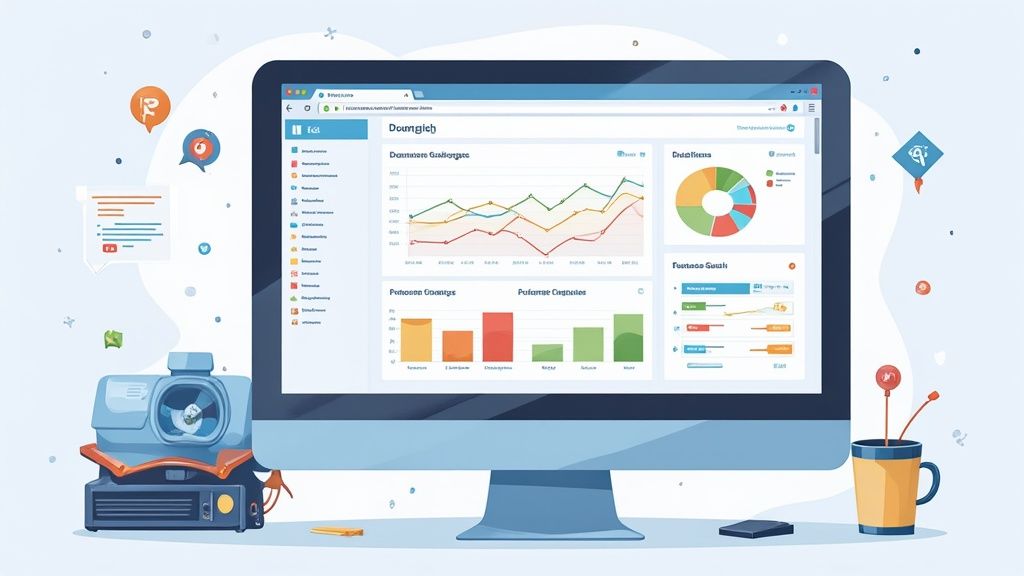
When it comes to reducing customer churn, building real connections with customers matters more than just offering great products. By getting to know each customer's unique needs and preferences, companies can create meaningful interactions that make customers want to stick around. This personal touch not only keeps customers happy but also helps businesses grow steadily and increase their profits.
Understanding Your Customers: Building a 360-Degree View
Getting to know your customers starts with looking beyond basic information like age and purchase history. You need to understand how they actually behave, what they like, and what problems they face. You can build this complete picture by gathering information from several sources:
- Website Activity: Look at what pages customers visit, which products they view, and what content they read to understand their interests
- Purchase History: Study what customers buy, how often they buy, and what types of products they prefer
- Customer Service Interactions: Learn from support tickets, chat conversations, and customer feedback forms
- Social Media Engagement: Watch how customers interact with your brand through likes, shares, and comments
Here's a real example: If you notice a customer frequently checking help articles about a specific feature, they might be struggling to use it. By reaching out with helpful tips before they get frustrated, you can keep them from giving up and looking elsewhere.
Crafting Targeted Retention Campaigns That Resonate
Once you really understand your different customer groups, you can create retention campaigns that speak directly to their needs. Consider grouping customers by:
- Product Usage: Split between heavy users and occasional users to adjust your message accordingly
- Demographics: Group by factors like age and location to make your communication more relevant
- Purchase Behavior: Look at past purchases to recommend products they'll actually want
For example, you might send personalized emails featuring products similar to what customers have bought before, or offer special discounts on items they've shown interest in. This kind of thoughtful, targeted approach makes customers feel valued and understood, which helps keep them coming back.
Choosing the Right Channels for Maximum Impact
Different customers prefer different ways of staying in touch. Some love getting emails, while others respond better to social media or text messages. Knowing these preferences helps you reach customers in ways that work best for them.
Here's how to make the most of each channel:
- Email: Perfect for sending personal newsletters, updates about products, and special offers
- Social Media: Great for building community feeling and sharing content from other customers
- SMS: Best for quick updates like order tracking or delivery notices
- In-App Messages: Helpful for showing customers how to use features while they're actually using your product
For instance, when new customers start using your product, sending them helpful tips through the app can make learning easier and encourage them to keep using it. By communicating with customers through their preferred channels and paying attention to their individual needs, you show them that you care about their experience. This personal touch makes them more likely to stay with your company instead of looking for alternatives.
Measuring and Optimizing Your Retention Efforts
Once you've put customer retention strategies in place, you need an effective way to measure their impact and make improvements. This means going beyond just tracking your churn rate to really understand why customers stay or leave. Think of it like regular health checkups – monitoring key metrics helps you spot issues early and take action before customers decide to leave.
Building a Comprehensive Measurement Framework
Your measurement system should look at both what's already happened and what might happen in the future. Past metrics like churn rate tell you the results of previous efforts, while early warning signs like decreased product usage or more support requests can help you spot potential problems. For example, if you notice certain customers logging in less frequently, you can reach out to understand why and offer help before they cancel. By tracking both types of metrics, you get a complete picture of how well your retention efforts are working.
Analyzing Customer Behavior Patterns and Seasonal Trends
To effectively keep customers around, you need to understand how they actually use your product or service. Look closely at which features they use most, when they need help, and what problems they run into. Also pay attention to how seasons affect customer behavior. A meal delivery service might see more cancellations during holiday seasons when people travel. When you understand these patterns, you can plan ahead – maybe offering special deals during typically slow periods or checking in with customers before they normally cancel.
Tracking, Reporting, and Continuous Improvement
Regular reporting on your retention efforts shows whether your strategies are paying off and helps you make better decisions. Clear reports that show the impact of your work help justify spending on customer retention and point the way to improvements. Set up regular check-ins to review your data and adjust your approach based on what you learn. Just like tending a garden requires consistent care and adjustments, maintaining strong customer relationships needs ongoing attention and refinement based on results.
When you take this measured, data-driven approach, you can clearly see what works best for keeping customers happy and loyal. Understanding both the numbers and the human factors lets you spot problems early and focus your efforts where they'll have the biggest impact.
To make tracking customer feedback easier, try SupportMan. It connects your Intercom ratings directly to Slack, giving you instant updates so you can quickly address any issues. Start your free trial today at https://supportman.io.

